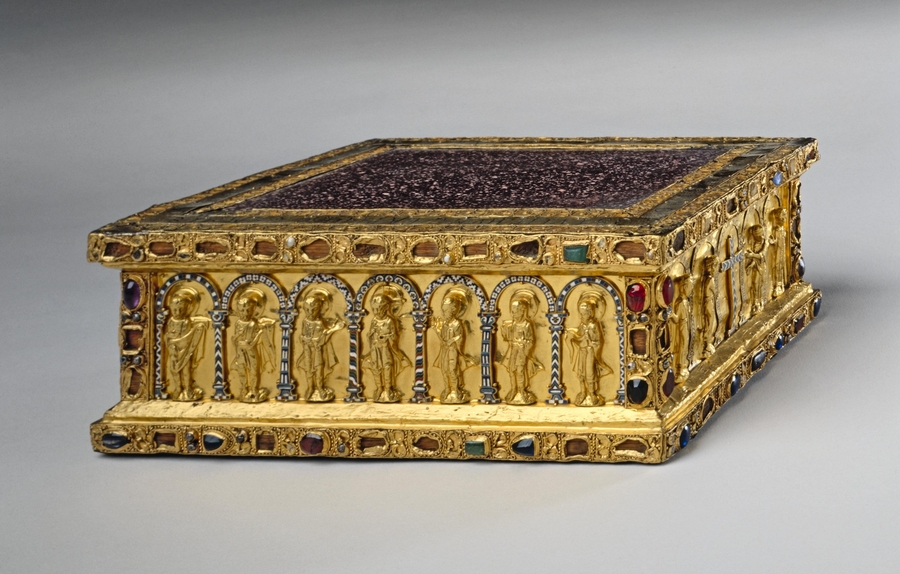This eleventh-century Christian portable altar, made in Germany, likely lower Saxony, typifies the splendid craftsmanship of Romanesque goldsmiths.
A portable altar is a wooden or stone tablet, or a cloth, on which Mass is celebrated.1 It is required in most of the older Christian traditions (the Catholic, Orthodox, and some of the Oriental Orthodox and other Eastern churches) when no permanent altar is available. The portable altar seems to have developed in the missionary world of the seventh century, to meet the Church's requirement that Mass be celebrated only on a consecrated altar—a requirement that strengthened the position of bishops, who alone could consecrate them. The oldest surviving portable altars are from St Cuthbert's shrine in Durham (ca. 660) and from Takrit in Iraq (709-10).
In all the churches that use them, the portable altar has been considered sacred—in some intensely so. Examining the different ways by which portable altars gain this sanctity helps expose their history, function, and significance.
Every portable altar has to be consecrated by a bishop through the application of holy oil. In the Orthodox Church each antimension is signed by the consecrating bishop.2 Through this consecration the portable altar becomes a “sacred place,” and like many a sacred place it is often the focus of power-struggles and politics. In obtaining a portable altar of their own, the medieval nobility and gentry gained independence from the parish clergy, while the right to grant such altars enhanced the power of bishops. Bishops granted the altars to laypeople over the heads of their clergy, and Popes granted them to monks over the heads of the bishops.
The portable altar becomes sacred, too, through its very use for the celebration of Mass—indeed, in all traditions the rite of consecration involves a Mass.
Portable altars are made from a wide variety of materials, but in the medieval West in particular the materials were chosen for their perceived innate powers rather than merely for their practicality or even for their symbolism. In the West stone soon replaced wood as the material of choice; the favorites for the altar-stone itself were jasper and porphyry, generally set in an oak frame. Medieval writers attributed great powers to gemstones, both healing and protective powers, and powerful symbolism.3 Whenever possible suitable gemstones were added to the portable altar. The powers of emeralds were also attributed to jasper, and those of rubies to porphyry. The use of gemstones in Christian art was by no means purely decorative; for believers, the stones did things.
Although the cross may serve merely as a symbol of adherence to Christian faith, or even just as decoration, there has been a cult of the Cross since the beginnings of Christianity, and the Cross has been venerated as an instrument of great power. Whether carved, painted, incised, or described by a gesture of the hand, the Cross can heal and protect. It is not surprising to find crosses permanently marked on portable altars.
By the ninth century in the West, the portable altar and another object, the reliquary, had begun to converge, so that portable altars always contained relics (Orthodox antimensia also have relics sewn onto a little cloth pocket on the back). The grandest became in form more like elaborate boxes than tablets or stone slabs. Great churches in the medieval and early modern West owned many of them, and there seems little doubt that they were used as altars only rarely, but were instead exposed for veneration like other relics.
A few portable altars, by association with a particular saint, became themselves relics. Thus Durham claimed Bede's portable altar as well as Cuthbert's, and Peterborough held two such altars made from the floorslab on which Thomas Becket died, and one made of stone from the tomb of St. Mary.
Many portable altars in the early Middle Ages were primarily intended as luxurious gifts. Portable altars were one example of a whole range of (often almost unimaginably extravagant) altar furnishings, relics, plate and manuscripts that bishops and wealthy laymen were expected to commission for donation to churches. In a culture that stressed physical appearance and external gesture as expression of inner virtue, extravagant religious gifts were seen as a proper part of religious life. Here is another layer of sanctity: the role of the gift as an expression of piety and generosity.
The iconography of portable altars has also contributed to their sanctity, especially in the Middle Ages. Many have elaborate iconography referring to the Mass, redemption through Christ, and to the saints whose relics they contain. Some also have inscriptions, sometimes commemorating the donor. Here the motive may be not just boastfulness, but the desire to associate one's name intimately with holy things.
One final level of sanctity comes from the symbolic association of the portable altar with sacred things and places. Thus in the West it is commonly referred to as The Holy Sepulcher, but in Ethiopia the altar (called a tabot) is also identified with the Ark of the Covenant, the Womb of Mary, the saints, or even Christ himself.
Notes
Notes
1. For more information, see Crispin Paine, “The Portable Altar in Christian Tradition and Practice,” in Objects in Motion: the Circulation of Religion and Sacred Objects in the Late Antique and Early Medieval World, ed. Hallie Meredith (London: British Archaeological Reports, 2011).
2.The antimension is the Orthodox equivalent of the portable altar. It serves the same function and fulfills many of the same roles. It is, however, almost always made of cloth rather than the wood or stone of the Catholic and Eastern churches.
3. For more information on gemstones, see Genevra Kornbluth, Engraved Gems of the Carolingian Empire (University Park, PA: Pennsylvania State University Press, 1995).
Keywords
Imprint
10.22332/con.obj.2014.47
1. Crispin Paine, "Portable Altar of Countess Gertrude," Object Narrative, in Conversations: An Online Journal of the Center for the Study of Material and Visual Cultures of Religion (2014), doi:10.22332/con.obj.2014.47
Paine, Crispin. "Portable Altar of Countess Gertrude." Object Narrative. In Conversations: An Online Journal of the Center for the Study of Material and Visual Cultures of Religion (2014). doi:10.22332/con.obj.2014.47



